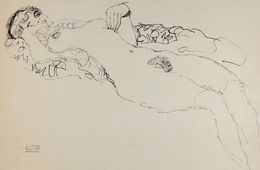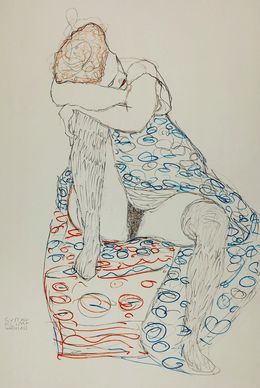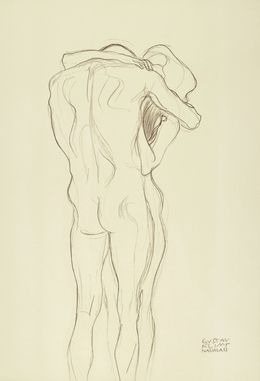
La Danseuse de Cabaret / Liegender Mädchenakt nach links / Reclining female nude facing left - 1914
Gustav Klimt
Print - 54 x 69 cm Print - 21.3 x 27.2 inch
$1,332
Gustav Klimt was an Austrian symbolist painter and one of the most prominent members of the Vienna Secession movement.
Gustav Klimt was born on 14 July 1862 in the suburbs of Vienna, and very soon showed a talent for drawing and painting. He studied at the School of Decorative Arts in Vienna from 1876 to 1883 and, in 1879, began a career as decorative painter with the “Compagnie des Artistes", which he founded with his brother Ernst and their friend Franz Matsch. He mainly produced wall décors for public buildings, which he painted in the great academic tradition.
His love of naturalistic detail and the accuracy of his portraits soon made his reputation as an artist. The main features of his work were a profusion of detail, lavish décors and the use of colour. He was also known for his use of gold in his paintings. His nude drawings are still collected today. His artistic qualities were recognised in 1888, when he was awarded the Gold Cross for artistic merit by Emperor Franz-Joseph 1.
Inspired by Japanese etchings, symbolism and Art nouveau, Klimt gradually moved away from academicism. Advocating a renaissance of the arts against the moral order, he and other artists founded the Vienna “Secession" in 1897. The group had its own exhibition room and illustrated review and recommended circulating Art nouveau in Austria.
This was a very productive period for the painter, who produced a large number of paintings and around 4000 drawings. These included Pallas Athénée (Pallas Athene) which marked his emancipation from official art.
His major work during this period was a commission from Vienna University for three allegorical panels representing Philosophy, Medicine and Jurisprudence. These monumental works caused fierce debate due to their erotic character and the asymmetry in the composition. However, Philosophy was awarded the Gold Medal at the Paris World Fair in 1900.
Having fallen out with a number of artists in the group, Klimt left the Secession in 1905. He refined his style and produced some of his most famous works: Judith I (1901), Danae (1906) and Le Baiser (The Kiss) (1907-1908). The theme of the dominant woman recurs in Klimt's works, along with death and eroticism.
He also painted a few landscapes without people, which gives them a particularly peaceful quality. During the First World War, he no longer accepted public commissions, but produced portraits for private patrons. This work as almost a society portraitist enabled him to further refine his concept of women in painting.
Gustav Klimt died of apoplexy in 1918. He was the model and master for Egon Schiele and Oscar Kokoschka, but was also considered by the “Blaue Reiter" to be the forerunner of lyrical abstraction.

Print - 54 x 69 cm Print - 21.3 x 27.2 inch
$1,332

Fine Art Drawings - 57 x 35 x 0.2 cm Fine Art Drawings - 22.4 x 13.8 x 0.1 inch
$82,138

Print - 87 x 59 cm Print - 34.3 x 23.2 inch
$1,765

Print - 64 x 48 x 1 cm Print - 25.2 x 18.9 x 0.4 inch
$660

Print - 70 x 50 x 1 cm Print - 27.6 x 19.7 x 0.4 inch
$755

Print - 47 x 63 x 1 cm Print - 18.5 x 24.8 x 0.4 inch
$644

Print - 47 x 63 x 1 cm Print - 18.5 x 24.8 x 0.4 inch
$1,099

Print - 47 x 63 x 1 cm Print - 18.5 x 24.8 x 0.4 inch
$644


Print - 59 x 87 cm Print - 23.2 x 34.3 inch
Sold
What are their 3 main works?
What is Gustav Klimt’s artistic movement?
When was Gustav Klimt born?